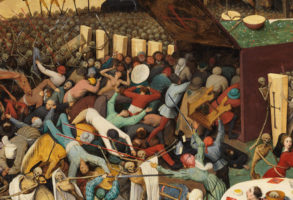
Published July 25, 2018
President Trump’s Helsinki press conference set off a global firestorm. The president quickly backtracked on some of his comments and now the Kremlin is demurring about attending a fall summit in Washington. The current controversy seems to be over, but as usual, the hullaballoo is overlooking the most important question: What should America’s role in the world be today? That, and not any particular thing the president has said, is what should now be the subject of intense debate.
Trump opponents left and right see no need for debate because they see no need for change. They believe the system of alliances and interlocked global trading networks that America created—at its insistence—after World War II continues to work in America’s interests. Nothing to see here, they intone, as if it were perfectly obvious the system works as intended.
These men and women may be right, but they have a tiny little problem: increasing numbers of Americans disagree.
Trade unionists have always worried about expanding the trade networks beyond First World, highly developed countries. In recent years they, have been joined by progressives who wonder if the networks spread that dreaded disease, “global capitalism,” leading to increasing income inequality at home and thinly disguised slave labor abroad.
They have now been joined by millions of non-unionized, or formerly unionized, blue-collar workers who have seen their industries and communities devastated since NAFTA’s signing and particularly since China’s accession to the World Trade Organization. Polls regularly showed that these workers thought global trade was a bad deal for America before Trump. One can debate how important this issue was to the millions who decided to switch parties and back the president, but one can plainly see that it was far from the backs of their minds.
Failure in Iraq and a 16-year-long war in Afghanistan also contribute to discontent with America’s global alliance system. President Obama was elected partially on his opposition to the Iraq War and his clear hesitation about the frequent use of America’s military. Trump echoed Obama’s hesitation, with the exception of crushing ISIS. Polls pre-Trump had also shown that such hesitation was shared by a large number of non-progressives, especially those blue-collar workers who thought overseas involvement was yet another example of an elite who care more about foreigners than they do about Americans.
The spread of these beliefs, especially among the politically crucial blue-collar swing vote in the Midwest and Mid-Atlantic states, means that status quo advocates need to make arguments, not assertions, if they want America to stay its course. Too many people have been hurt or feel disadvantaged by the current system for its continuance to be a matter of tacit consent.
The original system was created because it addressed real problems that demanded real solutions. The Great Depression’s catastrophic effects were exacerbated by high tariffs; the free trade regime was meant to ensure that this would never again occur. Multilateral trade regimes served a second purpose: they tied the global economies of free nations together so that they both had less interest to fight one another and greater means to fight a common enemy.
That common enemy, the Soviet Union, was also the spur for the global alliance system. America initially thought such means were unnecessary, relying instead on the newly created United Nations to ensure global peace. In the aftermath of the horror of World War II, which arose in part because of the lack of American involvement in the post-World War I League of Nations, this made some sense. But Soviet behavior soon proved the contrary. When the Soviets installed puppet Communist regimes in the parts of Europe the Red Army occupied, America realized it had to do something different if it wished to avoid standing alone against a Communist tide.
That something different involved two things: building a large peacetime standing military for the first time in our history, and joining extensive multinational alliances, also for the first time in our history. America had demobilized its massive military force after the end of World War II, but reversed course in 1948 as Soviet intentions became clear. NATO was formed in April 1949, placing America into regular military involvement in intra-European conflicts for the first time.
It’s often forgotten today that NATO was not America’s only global multinational alliance system designed to contain the Soviet Union. SEATO, the Southeast Asia Treaty Organization, was formed in 1954 to combat Communist expansion in the Pacific while CENTO, the Central Treaty Organization, was formed in 1955 to operate on the Soviet Union’s southern border. Both treaties were dissolved in the late 1970s after American geopolitical reversals—the fall of Vietnam and the overthrow of the Shah—led to member states losing interest. But as with NATO, these alliances had a clear goal: protect the United States from Communist and Soviet attack.
Today’s global alliance system lacks such a unifying and immediate threat. Russia is clearly not a friendly power, but no one seriously thinks it poses an immediate military threat to the United States or to any Western European state. China is also not a friendly power, but its ability to challenge America militarily is decades away. Iran is a regional power, not a global one. And North Korea’s threat is purely nuclear: there’s not much our alliance structure can do to prevent a direct attack, and it’s not likely our allies would support a preemptive one.
In the absence of this threat, alliance advocates need to make the case why it is in America’s interest to spend its soldiers’ blood and its citizens’ money to maintain it. That will require an argument—about the nature of geopolitics, about the nature of military power, and about the nature of modern war. America has always rested comfortably behind its oceans, secure in the knowledge that it readily had time and material to build a military defense should a hostile power arise. But in a world where airplanes can traverse the globe and it takes roughly four to five years to build just one supercarrier, America won’t have time to build once a clear and present danger materializes. Alliances help keep the threat at bay, advocates could plausibly claim, and keep us more secure than going it alone ever could. But to do that they need to actually, you know, make the argument.
Today’s global trading system also needs fresh arguments to sustain it. Trade in the 1950s, when goods were expensive to ship and costly communication kept services close to home, is materially different than in today’s world. Furthermore, the global trading system the U.S. built in the 1950s purposely did not include hostile countries that could use that trade to strengthen their economies and militaries. Today’s inexpensive transportation and instantaneous competition place much more pressure on domestic companies and domestic labor. And both China and Russia use access to that system to strengthen what otherwise could be very weak regimes, which in turn allows them to project power abroad against friendlier and more hospitable regimes.
One could argue why the current course is still in our interest, or argue for some prudential adjustments that keep the basic structure intact while minimizing some of the new side effects. But instead of arguments, you hear . . . nothing.
President Trump is implicitly challenging the existing order, but he is not providing a coherent rationale for why and provides virtually none for what would take its place. This means that there is no debate at all at the very moment when actions and events are putting our decades-old foreign policy to the test. Whether one’s sympathies lie with the old or with some sort of new, America will not be well served unless our actions are thought through and intentional. That means the sooner this debate occurs the better.
The old-fashioned conservative instinct to conserve can prevail for some time in the absence of such a challenge. But it will not sustain a system forever; the world has changed since the 1950s and certainly since 1989. People for or against Trump’s actions need to do more than yell; they need to persuade. The American people are eager to listen: let the contest begin.
Henry Olsen is a senior fellow at the Ethics and Public Policy Center, a think tank in Washington D.C. He is also an editor at UnHerd.com where he writes about populism and politics around the world. He is the co-author, with Dante Scala, of The Four Faces of the Republican Party (Palgrave, 2015) and is the author of The Working Class Republican: Ronald Reagan and the Return of Blue-Collar Conservatism (HarperCollins, 2017).





